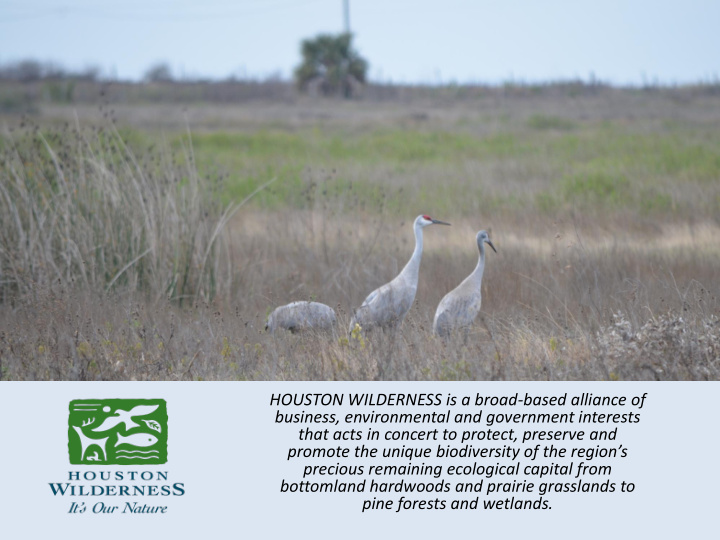



HOUSTON WILDERNESS is a broad-based alliance of business, environmental and government interests that acts in concert to protect, preserve and promote the unique biodiversity of the region’s precious remaining ecological capital from bottomland hardwoods and prairie grasslands to pine forests and wetlands.
10 Ecoregions (7 Land-based + 3 Water-based) Land-based • Prairie Systems • Trinity Bottomlands • Pineywoods • Big Thicket • Post Oak Savannah • Columbia Bottomlands • Bayou Wilderness Water-based • Coastal Marshes • Galveston Bay/Estuaries • Gulf of Mexico
Houston Wilderness Slate of Initiatives I. Convening – Collaborative Access Program (CAP) – Collaborative Grant-organizing Program II. Problem Solving – Sam Houston Greenbelt Network – Ecosystem Services Assessment in Greater Houston Area III. Educating – Houston Wilderness Website: houstonwilderness.org/gulf-restoration-funds/ – Get Outdoors Houston! Website and Ecotourism – Wilderness Passport / Ecotourism Passport
Houston Wilderness Convening Process I. Colleague Level II. Collaborator Level III. Facilitator Level
Collaborative Grant Organizing (CGO) • What is CGO? Houston Wilderness’ CGO Program brings multiple stakeholders in the region together to discuss opportunities for packaging multiple projects into one large funding request for federal and state granting entities. Once a regional request is targeted, HW administers the submission of the grant with the targeted partners. • Why CGO? Similar or related regional projects help to increase the chances of receiving funding by leveraging costs and providing a bigger regional impact. • Success - We have submitted over 8 Collaborative Grants since 2013 and received positive feedback from multiple federal & state grantors. We have received federal funding for the regional Houston Urban Refuge Initiative and have a large regional grant pending with TCEQ for four Cypress Creek Ecosystem Services Studies .
Gulf-Houston Regional Conservation Planning Group
Regional Gulf-Houston Planning Group Meetings
Gulf-Houston Regional Conservation Impact Plan Vision Maps
Existing Ecological Areas in 8-County Region around Houston
Next Steps for the Regional Conservation Plan (1) Finalize the Working List and Regional Projects (2) Meet with Business Group to discuss RCP vision map (3) Circulate and publish the RCP map and plan (4) Meet with pertinent Gulf Oil Spill officials (5) Submit RCP collaborative regional grants
Recommend
More recommend